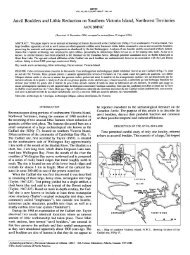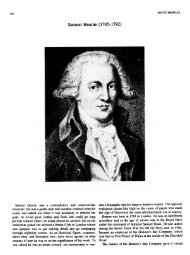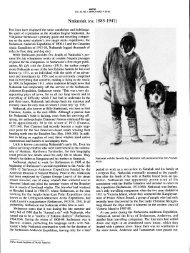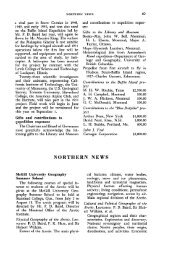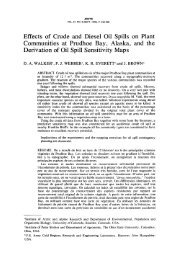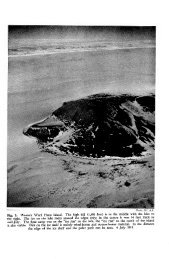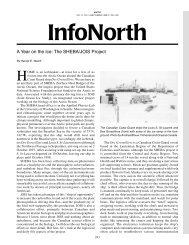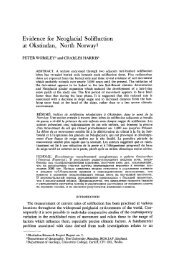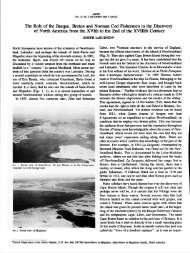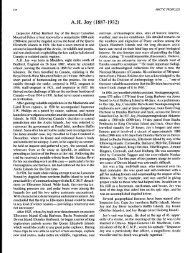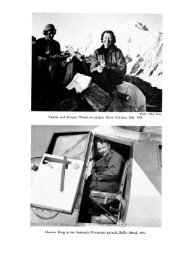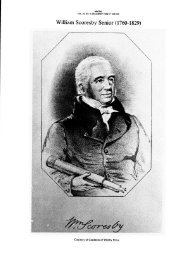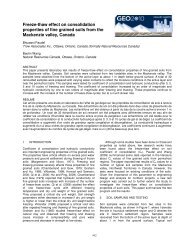Clothing in the Arctic - AINA Publications Server
Clothing in the Arctic - AINA Publications Server
Clothing in the Arctic - AINA Publications Server
You also want an ePaper? Increase the reach of your titles
YUMPU automatically turns print PDFs into web optimized ePapers that Google loves.
72 I T.G. SVENSSON<br />
dislocation <strong>in</strong> <strong>the</strong> 1920s follow<strong>in</strong>g an authoritative decision to but also about <strong>the</strong> Shi culture us<strong>in</strong>g <strong>the</strong> motifs of <strong>the</strong> stamps<br />
remedy overpopulation <strong>in</strong> <strong>the</strong> nor<strong>the</strong>rn districts. These people as po<strong>in</strong>t of reference (Heikka, 1989).<br />
were resettled <strong>in</strong> Central and South Shi areas and still, <strong>in</strong> <strong>the</strong><br />
second or third generation, cont<strong>in</strong>ue to wear Karesuando coats.<br />
Evidently, place of family orig<strong>in</strong> means more than actual iden-<br />
The symbolic power of <strong>the</strong>se stamps depict<strong>in</strong>g Shi cloth<strong>in</strong>g<br />
is fur<strong>the</strong>r streng<strong>the</strong>ned by <strong>the</strong> term Sdpmi - <strong>the</strong> SBmi land<br />
- added to <strong>the</strong> stamp beside <strong>the</strong> national designation “Sverige.”<br />
tification with <strong>the</strong>ir local milieu and its specific cloth<strong>in</strong>g style. This unusual addition was suggested by <strong>the</strong> artist, and after<br />
<strong>Cloth<strong>in</strong>g</strong>, or parts <strong>the</strong>reof, not only communicates ethnic some deliberation <strong>the</strong> idea was f<strong>in</strong>ally agreed upon by <strong>the</strong><br />
identity or o<strong>the</strong>r status manifestations. It may also convey mes- Swedish postal authorities. Sdpmi <strong>in</strong>dicates <strong>the</strong> Shi liv<strong>in</strong>g <strong>in</strong><br />
sages of sentiment, such as, for example, <strong>in</strong> <strong>the</strong> case of parents three different Nordic countries, to whom national boundaries<br />
disapprov<strong>in</strong>g a marriage union. Traditionally, <strong>in</strong> Kautoke<strong>in</strong>o have little mean<strong>in</strong>g (Fig. 22).<br />
such disapproval was expressed dur<strong>in</strong>g <strong>the</strong> wedd<strong>in</strong>g by means In a series of stamps featur<strong>in</strong>g various folk costumes,<br />
of <strong>the</strong> parents turn<strong>in</strong>g <strong>the</strong>ir dist<strong>in</strong>guished belts, adorned with Norway issued <strong>in</strong> <strong>the</strong> same year a stamp show<strong>in</strong>g a young<br />
fairly large square-shaped silver buttons, <strong>in</strong>side out (Hata, Shi dressed <strong>in</strong> Kautoke<strong>in</strong>o man’s costume. This stamp, how-<br />
1975:233).<br />
ever, was not designed by a SBmi and is not engraved.<br />
Internally, <strong>the</strong> elaboration of ornamentation may, moreover,<br />
<strong>in</strong>directly express local prestige. In Karesuando, for example,<br />
Consequently, it is not equally dist<strong>in</strong>guished (Fig. 22).<br />
<strong>the</strong> men’s coats are as a rule more lavishly decorated than<br />
women’s coats. This conspicuous adornment may be used as a<br />
symbol of boast<strong>in</strong>g - women could signal <strong>the</strong>ir sew<strong>in</strong>g skill<br />
CONCLUSION<br />
In this paper special emphasis has been put on <strong>the</strong> symbolic<br />
to impress o<strong>the</strong>rs by means of hav<strong>in</strong>g <strong>the</strong>ir husbands and sons study of cloth<strong>in</strong>g. <strong>Cloth<strong>in</strong>g</strong> is viewed as a social fact hav<strong>in</strong>g<br />
wear exaggeratedly decorated costumes (see also Porsbo, 1988). def<strong>in</strong>ite communicative power. The assumption that cloth<strong>in</strong>g<br />
The shape of Shi cloth<strong>in</strong>g is not static; <strong>in</strong> order to meet has communicative power relates to established <strong>the</strong>ory <strong>in</strong> ethnimodern<br />
requirements and aes<strong>the</strong>tic tendencies it may vary<br />
accord<strong>in</strong>g to changes <strong>in</strong> fashion generally. The women’s coat<br />
city studies where ethnicity is viewed as a socio-organizational<br />
phenomenon with its own dynamic of boundary ma<strong>in</strong>tenance<br />
<strong>in</strong> particular has tended to follow <strong>the</strong> directions of fashion and communication of ideas and identity manifestations across<br />
concern<strong>in</strong>g length of skirt; occasionally even m<strong>in</strong>iskirt models<br />
have been adopted (Utsi, 1986). Also <strong>the</strong> basic colour of <strong>the</strong><br />
such ethnic boundaries (Barth, 1969).<br />
With this assumption <strong>in</strong> m<strong>in</strong>d, <strong>in</strong>ter-ethnic relations on<br />
coat may be replaced by small-patterned fabrics, to which <strong>the</strong><br />
traditional strips of adornment are attached so that <strong>the</strong> cloth<strong>in</strong>g<br />
diverse levels of <strong>in</strong>teraction appear as <strong>the</strong> predom<strong>in</strong>ant contexts<br />
for <strong>in</strong>quiry. <strong>Cloth<strong>in</strong>g</strong> functions as a visible symbol of cullooks<br />
unmistakably Shi. Fur<strong>the</strong>rmore, new cloth<strong>in</strong>g design tural identity, and <strong>the</strong> actual mean<strong>in</strong>g <strong>the</strong>reof refers to both<br />
has been developed by a few creative designers among <strong>the</strong> values and identities. In o<strong>the</strong>r words, <strong>the</strong> manifestation of basic<br />
SBmi, who make fashion clo<strong>the</strong>s based on Sfimi colour and values and specific identity <strong>in</strong> concrete <strong>in</strong>teraction contributes<br />
shape but which are free from traditional constra<strong>in</strong>ts (Fossbakk,<br />
1987). It is important that such new cloth<strong>in</strong>g design<br />
ma<strong>in</strong>ta<strong>in</strong> a notion of be<strong>in</strong>g ethnically specific, although it is<br />
worn more freely than <strong>the</strong> Shi costume proper.<br />
One of <strong>the</strong> most active fashion designers <strong>in</strong> Shi cloth<strong>in</strong>g<br />
is Rose-Marie Huva, a well-known SBmi artist and crafts<br />
worker from Jukkasjiirvi, <strong>in</strong> Swedish Lapland, who specializes<br />
to <strong>the</strong> consolidation of <strong>the</strong> form an <strong>in</strong>ter-ethnic relation takes<br />
(cf. Schneider, 1987). <strong>Cloth<strong>in</strong>g</strong> is only one of many symbols<br />
reflect<strong>in</strong>g ethnic identity. To re<strong>in</strong>force <strong>the</strong> mean<strong>in</strong>g of symbols<br />
such as cloth<strong>in</strong>g <strong>the</strong>y must be used <strong>in</strong> communication, both<br />
<strong>in</strong>ter-ethnically and <strong>in</strong>ternally. If we restrict ourselves to Shi illustrations of <strong>in</strong>ter-ethnic confrontations, as, for <strong>in</strong>stance, <strong>the</strong><br />
Alta Case or <strong>the</strong> Taxed Mounta<strong>in</strong>s Case, it is no overstatement<br />
<strong>in</strong> t<strong>in</strong>-thread embroidery. She was recently chosen as <strong>the</strong> first<br />
Shi to design stamps show<strong>in</strong>g SBmi-specific cloth<strong>in</strong>g motifs.<br />
The stamps were issued <strong>in</strong> spr<strong>in</strong>g 1989 and show one woman’s<br />
chest piece with collar from Jokkmokk and one man’s belt<br />
with typical belt-purse from <strong>the</strong> South SBmi region, all<br />
embroidered by t<strong>in</strong> threads <strong>in</strong> characteristic S6mi patterns;<br />
both show po<strong>in</strong>ted details <strong>in</strong> Shi cloth<strong>in</strong>g (Fig. 22). Accord<strong>in</strong>g<br />
to SAMEFOLKET, it is believed that <strong>the</strong>se stamps and <strong>the</strong><br />
<strong>in</strong>formation connected to <strong>the</strong>ir issue through diverse media<br />
will help to spread <strong>in</strong>formation not only about Shi cloth<strong>in</strong>g<br />
to assert that cloth<strong>in</strong>g conveys certa<strong>in</strong> rhetorical power (cf,<br />
Schwartz, 1979). This has to do with <strong>the</strong> deliberate wear<strong>in</strong>g of<br />
native cloth<strong>in</strong>g to streng<strong>the</strong>n and emphasize <strong>the</strong> idea of cultural<br />
diversity as a completion to <strong>the</strong> juridical argumentation.<br />
Usually it is its visual pla<strong>in</strong>ness that makes Sfimi cloth<strong>in</strong>g<br />
rhetorically forceful; cloth<strong>in</strong>g states a non-verbal fact that cannot<br />
be questioned, although it has noth<strong>in</strong>g to do with jurisprudence<br />
as such.<br />
The analysis of cloth<strong>in</strong>g <strong>in</strong> this symbolic sense will have<br />
little import unless it connects both to given circumstances,<br />
i.e., ecology, and to traditions or customs, which refer to culture.<br />
For <strong>the</strong> sake of recognition and approval, <strong>the</strong> dist<strong>in</strong>ctiveness<br />
of any cloth<strong>in</strong>g, symboliz<strong>in</strong>g identity <strong>in</strong> <strong>in</strong>ter-ethnic<br />
FIG. 22. Stamps issued <strong>in</strong> 1989 show<strong>in</strong>g Shi cloth<strong>in</strong>g details. Photo: Ann<br />
Christ<strong>in</strong>e Eek, Ethnographic Museum, Oslo.<br />
relations, must be based on such background factors. And<br />
<strong>the</strong>se latter determ<strong>in</strong>ants may even be modified as <strong>the</strong> cloth<strong>in</strong>g<br />
is tried out symbolically <strong>in</strong> various <strong>in</strong>ter-ethnic contexts.<br />
Ethnic-specific cloth<strong>in</strong>g represents so much more than<br />
simply clo<strong>the</strong>s for protective purposes. It forms an essential<br />
part of a group’s cultural history. For <strong>the</strong> Shi m<strong>in</strong>ority this is<br />
obvious, as shown throughout this paper. Moreover, <strong>the</strong> issue<br />
of cloth<strong>in</strong>g is of great concern for <strong>the</strong> S6mi <strong>the</strong>mselves. In<br />
contrast to <strong>the</strong> development of tourist art <strong>in</strong> many Fourth World<br />
areas (Grabum, 1976), native cloth<strong>in</strong>g is not a response to commercial<br />
promoters from <strong>the</strong> outside but reta<strong>in</strong>ed and modified



